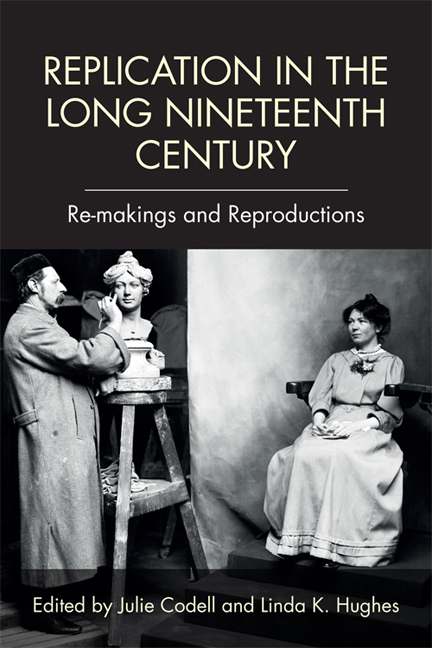Book contents
- Frontmatter
- Contents
- List of Illustrations
- Acknowledgments
- 1 Introduction: Replication in the Long Nineteenth Century – Re-makings and Reproductions
- I Replication and Networks
- II Replication and Technology
- III Replication and Authenticity
- IV Replication and Time
- 13 “Seeking Nothing and Finding It”: Moving On and Staying Put in Mugby Junction
- 14 The Origins of Replication in Science
- 15 Fathers, Sons, Beetles, and “a family of hypotheses”: Replication, Variation, and Information in Gregory Bateson's Reading of William Bateson's Rule
- 16 Afterword: The Implications of Nineteenth-Century Replication Culture
- Notes on Contributors
- Index
16 - Afterword: The Implications of Nineteenth-Century Replication Culture
from IV - Replication and Time
Published online by Cambridge University Press: 11 August 2018
- Frontmatter
- Contents
- List of Illustrations
- Acknowledgments
- 1 Introduction: Replication in the Long Nineteenth Century – Re-makings and Reproductions
- I Replication and Networks
- II Replication and Technology
- III Replication and Authenticity
- IV Replication and Time
- 13 “Seeking Nothing and Finding It”: Moving On and Staying Put in Mugby Junction
- 14 The Origins of Replication in Science
- 15 Fathers, Sons, Beetles, and “a family of hypotheses”: Replication, Variation, and Information in Gregory Bateson's Reading of William Bateson's Rule
- 16 Afterword: The Implications of Nineteenth-Century Replication Culture
- Notes on Contributors
- Index
Summary
We now live in a world dominated by replication. Our notions of simulacra, virtual reality, genetic engineering, and digital culture, and our anticipations of technological singularity, when computers transform and then surpass human intelligence through nanosecond replication and inaugurate the post-human, may seem a world away from the nineteenth century. Yet our current world has emerged from a complex cultural legacy that the preceding essays outline. In this brief afterword we reflect on nineteenth-century replication as the pre-history of our own era.
As Jay David Bolter and Richard Grusin point out in Remediation, the very terms we use in our computer-networked professional lives replicate old media terms. We call the electronic data that we share via computer transfer a “file,” and we store our files in “folders,” which are usually represented in word-processing software or online “boxes” by icons based on paper or hanging folders that were once filed in cabinets (Bolter and Grusin). Some of us read scholarly publications in born-digital journals, but across the sciences, social sciences, and humanities many academic journals today – even the venerable Science, founded in 1880 – are issued in both old-media paper formats and new-media digital forms. Speaking of the digitized journals and related databases we access routinely, contributor James Mussell has emphasized that a digital “copy” is in fact not a “copy” but a replica edition that changes the original print edition, generating alternative metadata and networks in the process. Yet editorial interventions and the roles of anonymous workers in producing digital journals bear important analogues to journal publication in the nineteenth century (Mussell; see also Fyfe).
Other links between the nineteenth century and our digital era include what is now considered the first computer program, which was published by Ada Lovelace in 1843 after she and Charles Babbage discussed Babbage's plan for an analytical engine. Appropriately, this exciting narrative has recently been adapted by Sydney Padua in her graphic novel entitled The Thrilling Adventures of Lovelace and Babbage (2015). Padua's work even includes replicated nineteenth-century documents in her chapter appendices.
- Type
- Chapter
- Information
- Replication in the Long Nineteenth CenturyRe-makings and Reproductions, pp. 289 - 293Publisher: Edinburgh University PressPrint publication year: 2017

